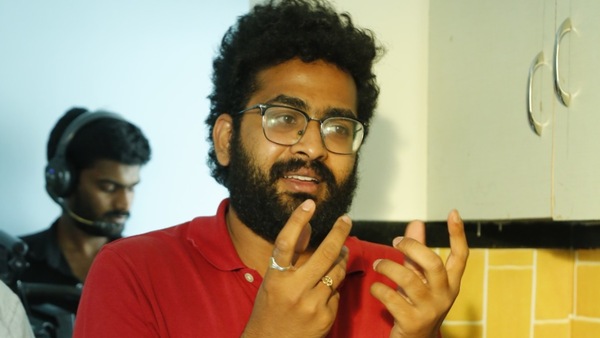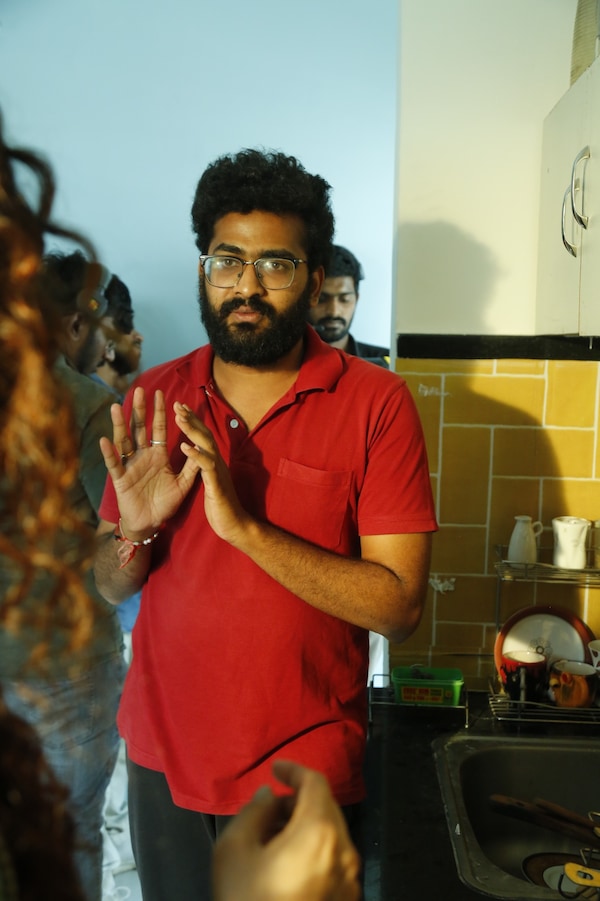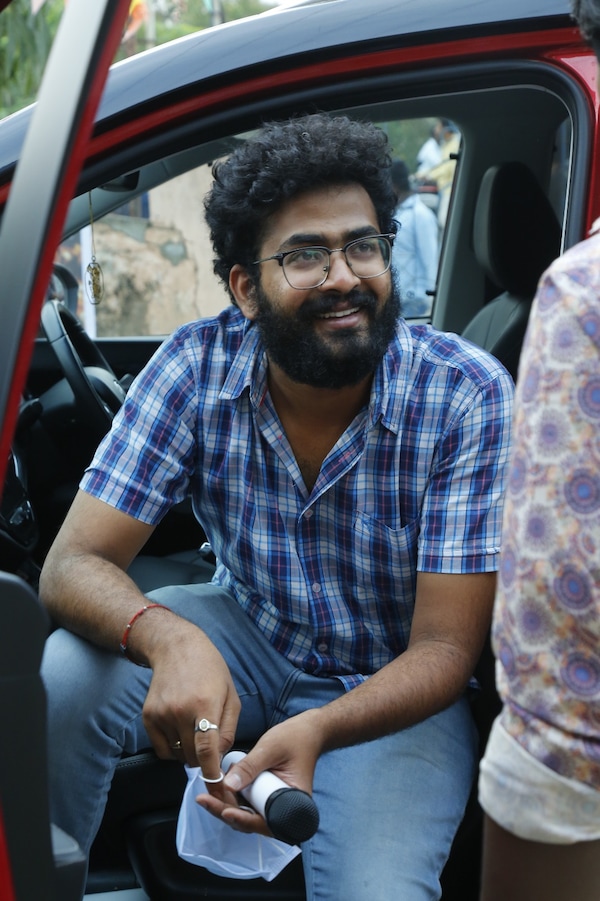Director Prabhala Tilak on Anger Tales: I liked the idea of interpreting the same emotion in different stories | Exclusive
The filmmaker, who shot to fame with his short film Kalakaarudu, talks of his OTT debut, Disney+ Hotstar’s anthology Anger Tales

Last Updated: 09.04 PM, Mar 11, 2023
For a newcomer, Prabhala Tilak has an uncluttered mind. He has a good understanding of aesthetics, style and treatment and doesn’t try to overcomplicate filmmaking. As long as he sticks to cinema, he says the role is immaterial; what matters to him is the joy of the collaboration.
The mechanical engineer discovered his love for cinema through the films of K Viswanath and Mani Ratnam, vibed well with a bunch of film enthusiasts, made short films to kickstart his career. While his short Kalakaarudu grabbed eyeballs, he assisted on his filmmaker friend Sandeep Raj’s Colour Photo later.
As his OTT debut, Anger Tales, streams on Disney+ Hotstar, he offers a glimpse into his journey, in a conversation with OTTplay.com
In Kalakaarudu, you say the idea of leading a dissatisfied life is equivalent to suicide. How do you look back at that thought now?
Of course, it’s impractical; it’s the reason why it’s a short film and not reality. Every film is an opportunity to fit myself into a better philosophy by the day. Kalakaarudu is a product of my thoughts back then and I honestly find it amateurish today. As a piece of fiction, it has an impact and the theme sounds like a naive man’s wish, when I look back at it today.
Take us through your life before Kalakaarudu and how the short film exactly took off...
I’m a mechanical engineering student and I barely had friends in college. I wasn’t much into studies and was just passing my time. When I was in my third year of engineering, I started to watch films more aggressively. Though I’d heard of Mani Ratnam and K Viswanath before, I took a closer look at their works and they changed the way I looked at cinema/life.
Iruvar, Sagara Sangamam, Swathikiranam had a strong impact on me. I remember writing nearly a dozen articles on a few films when I joined Chai Bisket (where he’d begun his career) right after my engineering. Once my fascination for cinema took over, nothing else was in my control and I was making use of the opportunities coming my way.
Who recognised your ability to direct?
The Chai Bisket team was very supportive right from the beginning. I shared my ideas with (actor) Suhas, the co-founder Anurag Reddy and there was no discussion about my abilities. I learnt about the screenplay format online, wrote a script and gave it to them. They liked it, we made Kalakaarudu and when I look back at it - everything fell into place so well.
Later, I co-wrote Colour Photo along with Sandeep (Raj), another friend Raghu and was also the assistant director. The experience came in handy and sometimes the fear of failure helps you ensure that all plans are in place. Given Suhas and Sridhar, the producers of Anger Tales, are my friends too, I saw it as ‘my’ project and was quite conscious of the budget, taking care of day-to-day challenges in production. There was no self-doubt at any point; it was all about executing things as per plan.
How’d you describe your Colour Photo experience?
My role in Colour Photo was minimal, though I was there throughout the process. In terms of writing, I, another man Raghu and Sandeep used to discuss ideas and utilised what was the best for the film. Sandeep took care of the major chunk of the work. I was a disastrous assistant director on the field; so much so that I apologised to Sandeep after I finished shooting my directorial project.
I was never prepared to handle a lot of work on the film set and I found ways to escape tasks. Having had this experience, I realised the need to take good care of my direction team recently. I learnt a few lessons on how not to be a bad AD (laughs). Sandeep (Raj) was really helpful at that point There’s no scope for any creative differences with him, our connection is quite strong.
On dealing with the unexpected fame post-Kalakaarudu:
The fame post-Kalakaarudu was good while it lasted but it didn’t mean much later. It took me almost nine months to start something new. My perspective towards writing, and relationships changed. Ideas don’t come to me naturally on most occasions and I need to work towards them. Kalakaarudu, however, was a rare case where I developed the plot spontaneously.
After the short film, because I wasn’t a natural with writing, I was always worried if I’d be able to handle feature films. I even had the idea of joining a film school during my engineering days but didn’t give it a thought later. Given a chance, I don’t mind joining one today and would want to learn something new.
On the absence of a market/revenue model for short films
I did a short film nearly nine months after Kalakaarudu but I was not quite satisfied with how it shaped up. Beyond a point, I felt the market of a short film died a silent death. Nobody is interested to fund a short film these days because they no longer see a revenue model there. It couldn’t generate money beyond a point and it’s important to have a revenue model in place before you pitch something.
Finding your feet in the industry and the challenge of making a career in films:
I haven’t interacted much with the industry all these years and it perhaps explains my optimism. My friends - Suhas, Sandeep, Sridhar, Raghu and others in our batch - and parents were a great source of support. I confined myself to a small circle and we dealt with all challenges, however big or small, collectively. My parents were worried, but they never pressurised me.

Before we talk of Anger Tales, what’s your understanding of anger?
It’s great if you could control your anger or find a way to channel it constructively. It can lead you to something life-changing. Even in Anger Tales, the anger is not an impulsive/random reaction, there’s a purpose to it. The anthology is all about how four ordinary people give a direction to their anger and a purpose to it.
Are the four segments in the anthology different dimensions of your personality?
I always believe a film/story is a reflection of a storyteller’s mind/philosophy at a particular point in time. All the tales in the anthology are something I’ve gone through personally or are issues experienced by someone close to me.
The difficulty of selling an anthology:
The biggest difficulty for an anthology, I guess, is about selling it; the process was quite smooth with Anger Tales though. From my interactions, I understood that it’s not easy to sell different stories that don’t merge. I liked the thought of having multiple interpretations of the same emotion and you have the additional challenge of visualising them differently. I think I’ve managed to tell four distinct tales in terms of screenplay and treatment.
Developing a grasp over cinematic technique:
Language is something we use to communicate our thoughts. Cinema too is a visual storytelling language - there’s a grammar to it and you must convey your ideas clearly. I see technique as a tool and one shouldn’t try to use it to project intelligence. I take the opinion of many people to understand if my ideas/intent are translating onto the screen. I owe my understanding of these aspects to K Viswanath and Mani Ratnam - their cinematic language is very precise, clear and impactful.

The need to have four different cinematographers for four segments:
I wanted a tonal difference in each of my anthologies. I realised that with the same cinematographer, no matter how hard you try, one can sense the similarities in the lighting pattern and the style. Though it’s the same emotion, the aesthetics and treatment of all the stories in Anger Tales were distinct and it needed technicians with different styles.
I wanted the vibrancy of a music video/advertisement for Madonna Sebastian’s portion. For Bindu Madhavi’s story, I wanted it to be a fly on the wall and see how the families go about their life. There’s a frenetic pace in Venkatesh Maha’s film, the camera never stays still and keeps rushing from one point to the other. With Phani Acharya’s story, I wanted the setup to be cinematic and relatable.
Dealing with (directors) Tharun Bhascker and Venkatesh Maha as actors
When your team is driven by the same intent and hunger, the process becomes easier. With Tharun Bhascker and Venkatesh Maha, I only saw them as actors and they too treated me similarly - nothing more, nothing less. In the case of Venkatesh Maha, I thought Ranga could’ve only been played by a filmmaker with as much conviction in his work. Now that you’ve all seen his performance, I can’t visualise anyone playing it.
Wouldn’t you want to move out of your comfort zone of film-enthusiast friends for future projects?
I won't deny I am comfortable with the same set of people. However, is it interfering with my writing or execution? I don’t believe so. I can speak on behalf of Sandeep, Suhas, Sridhar and Raghu too. We connect a lot on a personal level and we communicate easily. How a filmmaker moulds his career is entirely dependent on his/her mindset.
Subscribe to our newsletter for top content, delivered fast.

